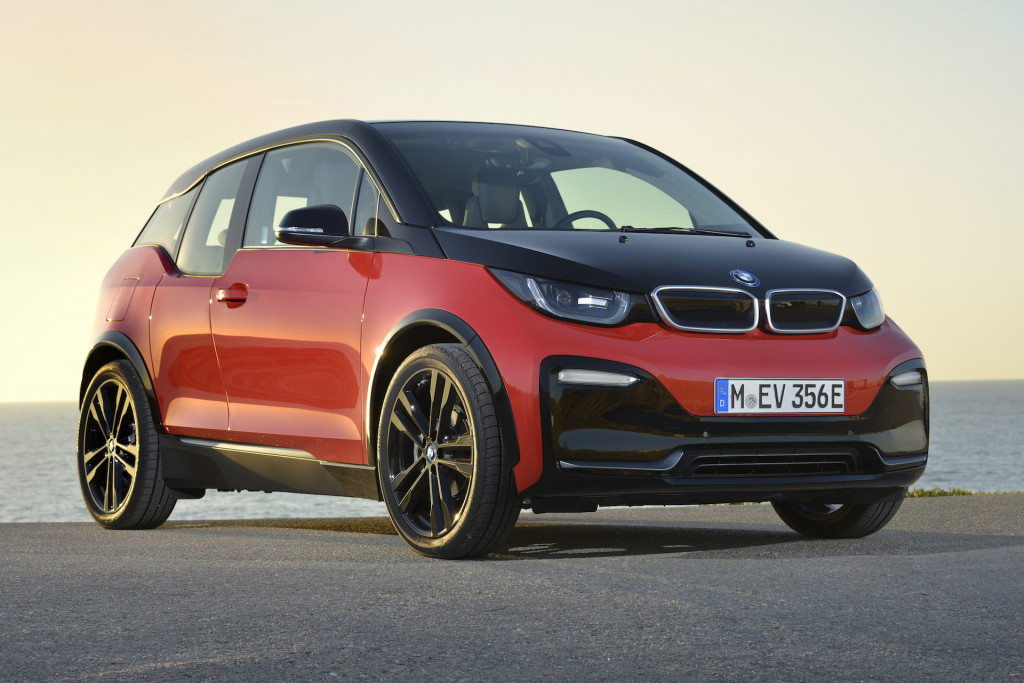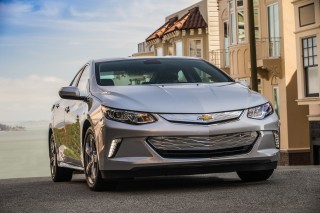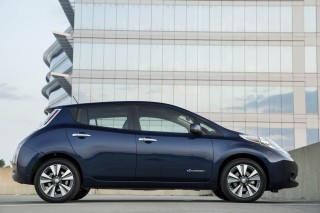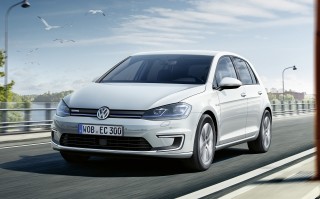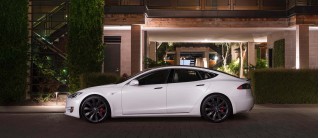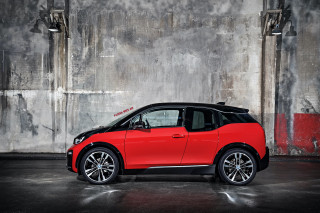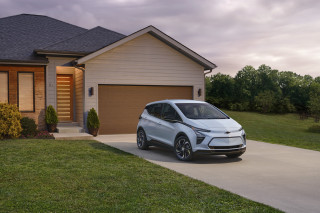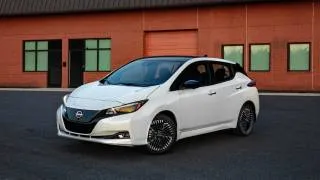Likes
- Smooth acceleration
- Agile urban handling
- Simple, elegant interior
- One-pedal driving
- Range extender option
Dislikes
- Polarizing style
- Lacks BMW's traditional dynamism
- Rear seat is compromised
- Range pales compared to newest rivals
Buying tip
features & specs
The BMW i3 is a wonder of technology, but it's already been surpasses by EVs with longer range.
The BMW i3 is an oddball. With carbon-fiber-intensive construction and an electric motor, it is the most environmentally forward-thinking car to come from BMW. Its design is polarizing, and it’s even unique among electric cars, as it offers an engine as an optional range extender. It comes in i3 and the new i3s models and instead of trim levels, it offers “Worlds”: Deka, Mega, Giga, and Tera.
While we like the i3’s unique character, the way it drives and accelerates, and its efficiency, it has its compromises. It’s costly, its range is far outstripped by newer rivals, and its skinny tires are a detriment to handling. After its 2014 introduction, it has aged quickly, and we give it a 6.6 out of 10 on our scale. (Read more about how we rate cars.)
The i3’s styling is the antithesis of the BMW brand. It has a tall, upright posture that is not pretty, but is distinctive. The wheels are pushed to the corners, and the profile is unique, mostly due to the odd window line that dips into the body line. Tall skinny tires create a strange look from the front or rear.
Inside, the look is more simple to the point of elegance. It has a Scandinavian influence, with an airy, open feel, and it makes smart use of recycled materials.
The i3 offers 114 miles of range from its 33-kwh battery, and a 2-cylinder range-extending (REx) 650cc engine boosts the total range to 180 miles, though its extra weight means the electric range falls to 97 miles. The engine produces 38 horsepower and 41 lb-ft of torque, but it doesn’t power the car; it just powers a generator, and it comes with a 2.4-gallon gasoline tank.
Newer EVs have considerably more range. The Chevrolet Bolt EV offers 238 miles of range, the Tesla Model S has up to 310 miles, and the Nissan Leaf offers 151 miles.
The i3’s electric motor spins up 170 horsepower and 184 pound-feet of torque. The new i3s model ups that to 184 hp and 199 lb-ft. The i3s also has more aggressive looks, a sport-tuned suspension, and a 0.4-inch lower ride height.
The motor delivers immediate and continuous power that launches the i3s from 0-60 mph in 6.8 seconds and the i3 in 7.2 seconds. Add the REx and its extra weight and those times take almost a second longer.
BMW offers several drive modes, including Eco Pro and Eco Pro+ that both deliver one-pedal driving due to aggressive brake energy regeneration.
The EPA rates the i3 as one of the most energy-efficient cars on the market, with ratings as high as 129 MPGe city, 99 highway, 118 combined (The Mile Per Gallon Equivalent unit, or MPGe, measures the distance a vehicle can cover on electricity on the same amount of energy contained in one gallon of gasoline.) BMW offers a home charging station rated at a hefty 7.4 kw, which charges the i3 in 4.5 hours..
The i3 offers a decent set of safety features, but they are mostly optional. The i3 has performed fairly well in crash tests performed by the IIHS but hasn’t been subjected to NHTSA testing.
BMW differentiates the Deka, Mega, Giga, and Tera Worlds stylistically, with unique wheel designs, upholstery choices, and interior colors. Standard features include heated front seats, satellite radio, navigation with real-time traffic, a rearview camera, automatic climate control, keyless access, and DC fast-charging.
2018 BMW i3 Styling
It may not be beautiful, but the 2018 BMW i3 is unique and forward-thinking, and its cabin is airy, elegant, and whimsical.
Unique, distinctive, and geek-chic, the i3 attracts onlookers who stop to gawk and ask questions, even though it’s not particularly attractive.
We rate the i3 a 6 out of 10 for styling. We recognize the exterior design is different, though odd. By contrast, the interior is soothing and it features reclaimed materials that fit with the image. While the body could have been drawn by a Silicon Valley tech startup, the interior seems like it belongs in a spa. (Read more about how we rate cars.)
The i3's design works best from the side, front, and front three-quarter views, aided mostly by the wheels-at-the-corners stance. That stance flows into a snub nose, as well as a tall and rather unique profile, but it also results in a solid, planted look. The profile has an almost van-like silhouette, and a window line that expands at the small rear doors, dipping into the body line, then pinches together at the rear. The tall and impossibly narrow wheels and tires help save fuel but look like mountain bike tires from the front or rear.
The i3s has slightly wider but still skinny tires, unique front and rear fascias, and a 0.4-inch lower ride height,
The BMW twin kidney grille up front is just for show, as the i3 doesn’t need the cooling of an actual grille.
From the rear, the look becomes confusing, with a blend of curves and straight lines that lacks consistency. If the whole car feels like a VW Beetle drawn on an Etch-A-Sketch, the rear is where that is most obvious.
The rear fascia and bumper appear as a separate piece that seems to grow out from below the high load deck. They also cover the area where the traction motor and drive unit sit. U-shaped taillights sit up high just below the hatch glass, and the body sides extend slightly past the tailgate. This either gives the i3 some sort of tail fin or strange rear jowls.
Inside, the look and feel are Scandinavian. A shelf-like dashboard has a tablet propped up on a central dip. This 10.2-inch screen is controlled by the iDrive knob on the center console.
BMW employs tightly woven textiles in light and dark hues to brighten the i3's cabin. Not only do they add a sense of elegance and even whimsy often lacking in the more staid standard-line models, but also many are made from recycled materials that fit with the i3’s mission.
2018 BMW i3 Performance
The 2018 BMW i3 is quick off the line, especially without the range-extending engine, and it offers the unique feel of one-pedal driving.
The i3 makes concessions for its efficiency, with skinny tires and a short wheelbase. The new i3s model is sportier and has wider tires, but grip is still compromised. The electric motor provides decent pep, though, and we give the i3 a 6 out of 10 for performance, adding one point for its motor performance and “one-pedal” driving experience. (Read more about how we rate cars.)
For 2018, BMW offers only the 33-kwh lithium-ion battery pack, dropping the 22-kwh pack, and adds the i3s model. Electric range tops out at 114 miles and the optional range-extending engine increases it to 180 miles.
The i3 drives the rear wheels with a 125-kilowatt (170-hp) electric motor that also makes 184 lb-ft of torque electric. The version in the i3s puts out 184 hp and 199 lb-ft of torque.
The optional range-extending combustion engine is the only one on the market for a battery-powered car. It's a motorcycle-based 650cc 2-cylinder that produces 38 hp and 41 lb-ft of torque. That doesn’t matter, though, because it doesn’t power the wheels. Instead, it runs a generator that recharges the battery to extend the range up to 180 miles. Its gas tank holds 2.4 gallons of fuel. That’s a tiny tank and it will require frequent fill-ups for anyone planning to run on gas without recharging, so it’s best not to think of the i3 as a road-trip car.
More than that, though, the REx doesn’t provide enough sustained electric current to provide the car with full power under sustained, heavy loads. In these instances, the speed can drop to as low as 45 mph and the REx howls at maximum output to recharge the battery enough to resume speed. Examples might include steep grades or highway runs when using all the accessories. This could prove either annoying or potentially hazardous if a driver were to rely on full power to get out of a tricky spot and find it’s not there.
Driving the BMW i3
BMW locates the i3’s start button behind the steering wheel on the inside of a rotary controller that also acts as a shifter. The electric parking brake sits on the center console at the base of the storage bin and armrest, far enough back that we couldn’t find it without assistance. A toggle on the center console lets the driver select the drive mode—“Sport,” “Comfort,” “Eco Pro" or "Eco Pro+,” the latter two of which stretch battery range about 12 and 25 percent, respectively, according to BMW.
How the i3’s motor acts will be determined by the chosen driving mode, though drivers can override the Eco Pro modes by simply flooring the throttle. These modes also don’t leave the car with dulled responses provided the driver is willing to get on the throttle hard enough.
The i3s adds the Sport mode and its additional power makes it the quicker of the two. From the driver’s seat, the Sport mode makes the throttle quicker to react and adds weight to the steering.
In any model, torque is smooth and continuous at take-off. The battery-only i3s reaches 60 mph in 6.8 seconds, while the i3 hits the mark in 7.2 seconds. Power is especially willing right from a stop, which makes the i3 quick from lights and especially responsive around town. The 0-35 mph sprint takes just 3.5 seconds in the base i3. The extra weight of the range-extending engine increases the 0-60 mph times to 7.6 and 8.0 seconds for the i3s REx and i3 REx, respectively. While i3 models top out at 93 mph, the i3s versions can hit 99 mph.
Eco Pro dulls the throttle response and lightens up the steering. This mode is programmable. It lets drivers choose a “top speed” between 50 and 80 mph, as well as a more efficient mode for the climate control system. Depending on those choices, a display on the center screen will show how efficiently you are driving, with the range falling between 70 and 100 percent. The throttle pedal will have a detent or dead spot at that chosen top speed, but it can be overridden with a hard stab of the throttle.
Eco Pro+ works like Eco Pro, but it automatically chooses a 56 mph “top speed” and a more aggressively restricted program for the heating and cooling.
The two Eco Pro modes also provide what is virtually one-pedal driving due to strong regenerative braking. Upon letting off the throttle, the car immediately begins to slow down instead of freewheeling. That means the brake pedal is usually only needed for the very few last feet of a complete stop. We even stopped on the downslope of a parking ramp when letting off the throttle. It also doesn’t have the usual idle creep you get with an automatic transmission, so drivers will have to get used to a new way of driving.
We recommend avoiding the REx for anyone who will use the i3 as a city car and not take it on longer trips. Highway driving saps battery range faster, so the REx is a good idea for those who will use the freeway on a regular basis. Be aware, however, that the i3 is susceptible to side winds.
The i3’s handling is unique. It’s crisp and nimble with a very tight 32.3-foot turning radius that lets it turn around on most streets. However, it has tall, skinny tires that can give up grip easily in an aggressive turn. It’s also prone to jittering and skipping through turns over broken pavement, and the tall ride height (occupants do sit on top of a battery back) amplifies the feeling of body roll.
The i3s is sportier, but not all that much. Its sport-tuned suspension has a 0.4-inch lower ride height, a 1.6-inch wider track, and firmer springs, dampers, and anti-roll bars. The tires are 175/55R20s up front and 195/50R20s in the rear compared to the 155/70R19s that come at all four corners of the i3. That gives the i3s more front-end grip, but less than the average car, and more overall agility.
Both models have a firm, but well controlled ride, though the i3s may be too stiff for those who want a pillowy ride.
2018 BMW i3 Comfort & Quality
A small car, the i3 has a tiny rear seat and a limited cargo area, though the front seats are quite comfortable.
The BMW i3 is a four-seater with a hard-to-access and small rear seat and a compact cargo area. We give it point for its comfortable front row, but take away points for the rear seat and cargo utility, rating the i3 a 4 out of 10 for comfort and quality. (Read more about how we rate cars.)
Occupants up front sit in thin, but comfortable seats attractively upholstered in mostly recycled materials. A more upright and higher seating position than most small cars affords a good view of the road. The steering wheel tilts over a wide range to tailor a comfortable driving position for just about anyone.
Getting in and out of the back, however, involves using the small, rear-hinged “carriage doors” that require the front doors to be open. The rear seats are placed farther back in the cabin than the doors reach, so occupants tend to flop into the seats, which also lack leg room. And with the battery under the floor, riders feet sit higher, creating a knees-under-the-chin feeling that gets uncomfortable on longer trips.
At speed, the motors and electronics create almost no whine, except at maximum power. The materials BMW has chosen for the i3 are appropriate and even stylish. The Giga World trim is particularly appealing, with its beautiful wool and olive leaf-tanned leather upholstery complemented by open pore eucalyptus wood trim that would look great in any kitchen or bathroom. BMW uses some molded black plastic elements, but they're in the background, with the lighter and more novel materials catching the eye.
2018 BMW i3 Safety
The i3’s active safety features are optional and it lacks complete crash-test ratings.
The BMW i3 offers a healthy set of safety features, but it hasn’t been fully tested by the agencies that crash test vehicles. Without full crash-test ratings, we can’t give it a score for safety.
Standard safety equipment consists of a rearview camera and six airbags, including front seat-mounted side-impact airbags designed for the car’s slim, lightweight seats.
An optional Technology + Driving Assistant package adds adaptive cruise control with stop and go and pedestrian warning with low-speed automatic emergency braking. Also available are front and rear parking sensors and an automatic parking system.
The i3 isn’t constructed like a typical car. It has a unique carbon fiber-reinforced plastic body mounted atop a rolling platform made of aluminum that also houses the battery and drive system.
It has performed well in its first crash test from the IIHS. The i3 received the institute’s highest rating of “Good” in the small overlap front driver-side, moderate front overlap, side, and roof-strength tests. It received only an “Acceptable” rating for its head restraints and seats, and it didn’t undergo the small overlap front passenger-side test. Its front crash protection system was rated “Advanced.” It misses a Top Safety Pick award.
The NHTSA hasn’t tested the i3.
Vision out the front of the i3 is a mixed bag. Forward vision is good, except for the area blocked by the large rearview mirror and camera housing above it. The rear three-quarters view and to the right side are just adequate. The rearview camera is important because the rear window is short and placed high.
2018 BMW i3 Features
The BMW i3 costs more than most electric rivals, but it offers a healthy set of customization options.
The i3’s base price is about $8,000 higher than that of the Chevrolet Bolt EV and $14,000 more than the Nissan Leaf’s. Adding options can make it climb quickly, including the range-extending engine.
We rate the i3 a 6 for features, giving it points for a vast array of customization options and a big infotainment screen, but taking one away for the relatively high price given its electric range. (Read more about how we rate cars.)
BMW offers its odd little EV in i3, i3 with Range Extender, i3s, and i3s with Range Extender models. The range-extending engine adds almost $4,000 to the price, and the i3s costs $3,200 more per model.
Versus the i3, the i3s has a sport-tuned suspension with a 0.4-inch lower ride height and a 1.6-inch wider track, wider 20-inch wheels and tires, and a Sport mode.
Rather than trim levels, BMW offers “Worlds,” including Deka, Mega, Giga, and Tera.
The Deka World comes with a dark cloth interior made from recycled materials, a universal garage door opener, navigation with real-time traffic, a rearview camera, heated front seats, HD and satellite radio, automatic climate control, keyless access, LED headlights, flat-faced 19-inch wheels, and a DC fast-charging capability using the Combined Charging Standard connector.
Mega World adds light-colored cloth and synthetic leather upholstery. The Giga World dresses things up a bit, but does add amenities. It includes wood and cloth upholstery, a leather-covered dashboard, wood trim, and unique alloy wheels. The Tera World adds full leather and alloy wheels of its own.
One package is offered. The Technology + Driving Assistant package includes upgraded navigation with real-time traffic and a dynamic range map, adaptive cruise control with stop and go, pedestrian warning with low-speed automatic emergency braking, and connected services that include stock and weather updates and Google online search.
Also offered are front and rear parking sensors, an automatic parking system, an upgraded Harman/Kardon audio system, Apple CarPlay, 20-inch wheels for the i3, and a sunroof.
2018 BMW i3 Fuel Economy
Without the range of its electric rivals, the i3 is best used as a city car, and it does that well.
The BMW i3 is one of the most energy-efficient vehicles sold in the U.S. in its battery-electric form. However, it’s still quite efficient in REx form engine, and its range is longer. We rate it a 10 out of 10 for fuel economy. (Read more about how we rate cars.)
This year, only a 33.2-kwh battery is available that delivers 114 miles of range in the i3 or 107 miles in the i3s.
Both come with or without the range-extending 650cc 2-cylinder engine that cuts electric range to 97 miles due to its extra weight, but brings the total range to 180 miles.
With the REx, the i3 and i3s are EPA rated at 109 MPGe and 35 mpg combined. Without the REx, the i3 is rated at 129/99/118 MPGe, while the i3s comes in at 126/99/112 MPGe.
In terms of overall efficiency, the i3 is near the top of the heap. It’s just shy of the Chevrolet Bolt, which is rated at 119 MPGe. The Bolt has more range, but requires more energy to charge. The Tesla Model 3 is the industry leader at 130 MPGe.
Most EV buyers are interested in range, and the Bolt offers 238 miles of range while the Tesla Model 3 extends that to 310 miles.
BMW offers a 240-volt Level 2 charging station that can work with the car’s onboard 7.4-kw charger to recharge the battery pack in about 4.5 hours. The 7.4-kw charger is faster than the Nissan Leaf’s 6.6-kw charging. Installing the Level 2 station may require some home electrical work like might be required for appliances. Charging the i3 on a standard 120-volt household outlet will take as many as 16 hours.
The i3’s standard DC quick-charging port works on the Combined Charging Standard protocol. While fewer charging stations use that standard than the CHAdeMO protocol, most new DC quick-charging stations are now "dual-standard," meaning they have a cable for each protocol.
